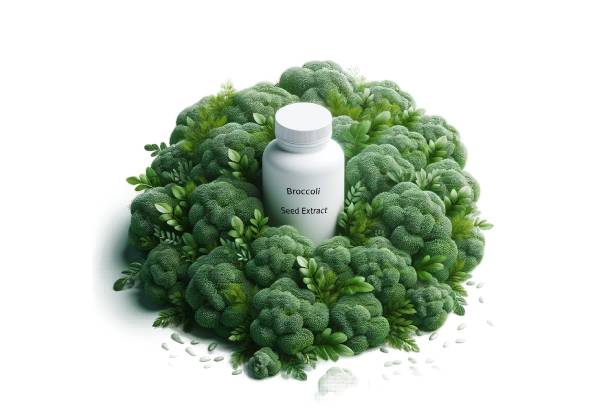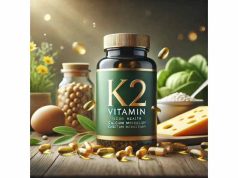
Broccoli seed extract—derived from the tiny seeds of the humble broccoli plant—has gained traction as a potent source of antioxidants and phytonutrients that may support healthy eyes. Despite broccoli’s longstanding reputation as a nutrient powerhouse, research is only recently uncovering how the concentrated substances in its seeds, including sulforaphane, might offer protection to vulnerable ocular tissues. With frequent screen exposure and environmental factors now placing added strain on our eyes, many are searching for natural solutions to maintain clarity of vision and comfort. This in-depth guide explores how broccoli seed extract may help preserve retinal health, why certain compounds in it can be beneficial, and tips on using it effectively as part of a broader eye-care regimen.
Table of Contents
- Broccoli Seed Extract Explained
- Ways Broccoli Seed Extract Supports Sight
- Primary Benefits for Ocular Health
- Optimal Ways to Use Broccoli Seed Extract
- New Studies and Ongoing Investigations
- Frequently Asked Questions
- References and Sources
Broccoli Seed Extract Explained
Historical Background and Nutrient Profile
Broccoli (Brassica oleracea var. italica) is a cruciferous vegetable famed for its vitamins, fiber, and health-protective compounds. Yet the seeds—often overshadowed by florets—house a potent cocktail of phytochemicals that have ignited scientific interest. In particular, broccoli seed extract is commonly standardized for sulforaphane, a sulfur-rich molecule associated with robust anti-inflammatory and antioxidant actions.
In traditional diets, broccoli seeds themselves weren’t typically consumed in large quantities—people favored the sprouted seeds or the mature florets. Over time, however, modern extraction techniques have enabled the creation of concentrated powders or capsules containing the seeds’ beneficial components, delivering a consistent dose of essential nutrients that may outpace normal dietary intake.
The Star Compound: Sulforaphane
Sulforaphane, generated when the seed’s enzyme myrosinase interacts with the compound glucoraphanin, stands out as the major functional factor in broccoli seed extracts. Key attributes include:
- High potency: Its molecular structure allows sulforaphane to directly spur certain cellular defense pathways.
- Activation of Nrf2: A genetic “switch” that elevates antioxidant and detoxification enzyme production.
- Multifaceted protective capacity: From modulating inflammatory signals to improving cellular detoxification.
This combination of antioxidant, anti-inflammatory, and detox support underscores sulforaphane’s broad promise for many tissues, including the retina and lens of the eye.
Common Forms of Broccoli Seed Extract
Broccoli seed extract typically appears as:
- Standardized sulforaphane capsules or tablets: Verified to deliver a measured mg of sulforaphane or glucoraphanin.
- Sprouting seeds: Some prefer to sprout them at home, though consistent dosing can be trickier.
- Powder blends: Occasionally found in “green superfood” powders, though the proportion from seeds can vary.
Regardless of format, verifying the actual sulforaphane or glucoraphanin content remains crucial, as raw seeds or untreated extracts may differ widely in potency.
Contrasting with Broccoli Florets or Other Crucifers
While raw or lightly cooked broccoli florets also supply sulforaphane, they can’t guarantee the uniform high concentrations found in the seeds or specially processed extracts. For ocular health, many experts prefer these extracts’ reliability in anthocyanin-like compounds and strong antioxidant capacity, delivering levels likely unattainable through normal dietary portions of broccoli alone.
Ways Broccoli Seed Extract Supports Sight
Although not initially heralded as an “eye supplement,” the protective attributes of broccoli seed extract make it a compelling contender for those seeking to maintain or optimize visual function. Below are key mechanisms by which the constituents—chiefly sulforaphane—may benefit ocular tissues.
1. Boosting Natural Antioxidant Pathways
One of sulforaphane’s most studied effects is the activation of the Nrf2 pathway. Once triggered:
- Nrf2 travels to the cell nucleus and binds to antioxidant response elements.
- Enzymes like glutathione S-transferases, heme oxygenase-1, and catalase are upregulated, enhancing the cell’s defensive capacity.
By augmenting these endogenous systems in retinal and lens cells, broccoli seed extract can potentially limit the destructive chain reactions of free radicals, which, if unimpeded, accelerate degenerative changes such as cataract formation or macular stress.
2. Maintaining Microcirculation in the Retina
The retina relies on a dense network of tiny blood vessels. Chronic oxidative or inflammatory insults can harm or narrow these capillaries, threatening photoreceptor integrity. Studies suggest that sulforaphane:
- Preserves endothelial function: Potentially improving nitric oxide availability, aiding vasodilation.
- Supports stable blood flow: Minimizing the risk of mini-leaks or hemorrhages in compromised vessels (common in borderline diabetic or hypertensive states).
By protecting these crucial microvessels, retina cells receive consistent oxygen and nutrient delivery, essential for sustaining crisp vision.
3. Minimizing Inflammatory Stress
Chronic inflammation—stemming from digital device overuse, environmental pollutants, or suboptimal diets—can aggravate dryness, irritations, or even progressive changes in the macula. Sulforaphane:
- Regulates cytokines: Lowering IL-1β, IL-6, or TNF-α levels known to hamper ocular surface or deeper tissues.
- Modulates immune responses: Easing local inflammation that might degrade tear film or further stress the retina.
Reduced inflammation correlates with less dryness, less frequent ocular redness, and improved tolerance to tasks like long reading or screen-based work.
4. Diabetes-Related Eye Protection
Poorly managed glucose can lead to microvascular harm and retinopathy, damaging vision. Early research into broccoli seed extract reveals:
- Enhancement of insulin sensitivity in certain test models, assisting metabolic equilibrium.
- Protective effect on small vessels and nerve tissues susceptible to glycemic damage.
By fostering metabolic stability, the retina experiences fewer glucose-induced destructive processes, a relevant factor for borderline or mild diabetics seeking to protect their vision.
5. Synergy with Other Ocular Nutrients
Many eye supplements revolve around established players like lutein, zeaxanthin, or astaxanthin. Broccoli seed extract might amplify these benefits by:
- Reinforcing antioxidant synergy: Combining sulforaphane’s detox effects with the direct macular shielding of lutein/zeaxanthin.
- Mitigating oxidative overload: That would otherwise degrade vitamins A, C, or E in ocular tissues.
Such synergy underscores how broccoli seed extract can slot into multi-ingredient approaches for comprehensive vision support.
Primary Benefits for Ocular Health
Many who take broccoli seed extract for its broader wellness effects report improvements that can extend to the eyes. Below are notable ways Broccoli Seed Extract Improves Vision for certain individuals.
1. Defending Against Cataract Formation
The lens, responsible for focusing light onto the retina, becomes cloudy over time in cataract conditions. Oxidative stress is a primary culprit. Through the induction of robust detox enzymes, broccoli seed extract:
- Staves off protein oxidation in the lens, possibly prolonging lens clarity.
- Supports lens epithelium health, lowering the rate of degenerative changes.
Though not a cure for existing cataracts, it may help delay onset or progression.
2. Reducing Digital Eye Strain and Fatigue
Modern reliance on screens fosters dryness, focusing strain, and low-level inflammation. Broccoli seed extract’s anti-inflammatory edge might:
- Calm ocular surface tissues prone to dryness from heavy device usage.
- Enhance resilience in eye muscles adjusting continuously for close focus, indirectly mitigating fatigue.
Combined with correct posture, good lighting, and screen breaks, it can yield a more comfortable visual experience day to day.
3. Preserving Macular Function
The macula, center of the retina, is critical for sharp central vision. Over time, repeated exposure to bright light or free radicals can degrade macular pigment. Broccoli seed extract’s antioxidant capacity:
- Reduces free radical burden in the macular region.
- Potentially extends healthy central vision for tasks like reading or driving.
Paired with recognized macular carotenoids (lutein, zeaxanthin), the synergy may be even stronger.
4. Easing Inflammatory Eye Conditions
If dryness or mild eyelid inflammations (like blepharitis) are linked to systemic or local inflammation, sulforaphane’s regulation of NF-κB and other pathways could:
- Lessen eyelid margin redness or swelling.
- Steady tear composition, limiting dryness that triggers stinging or blurred spots.
It’s no substitute for antibiotic or steroid treatments in severe cases, but for mild or chronic low-level issues, it might offer gentle relief.
5. Indirect Support Through Blood Sugar Balance
In borderline or mild diabetic eye scenarios, controlling glycemic levels is paramount. By boosting insulin sensitivity or controlling hepatic glucose release, broccoli seed extract:
- Curbs microvascular stress in the retina.
- Limits advanced glycation end products that degrade small vessels.
Though direct evidence specifically tying broccoli seed extract to preventing diabetic retinopathy remains preliminary, this metabolic dimension supports the notion of improved ocular outcomes.
Optimal Ways to Use Broccoli Seed Extract
An effective approach to Broccoli Seed Extract Eye Health involves selecting a standardized product, adhering to suitable dosing, and blending it into daily ocular hygiene.
1. Choosing a Quality Supplement
To harness consistent levels of sulforaphane and related compounds:
- Look for recognized brands specifying the mg of glucoraphanin or sulforaphane.
- Assess synergy with complementary extracts (like black pepper or mustard seed) that can boost sulforaphane bioavailability.
- Avoid unverified claims: If a supplement doesn’t reveal standardized amounts, you could be left guessing dosage and potency.
Additionally, some advanced formulations deliver myrosinase (the enzyme that activates sulforaphane in the gut), ensuring you actually reap the compound’s benefits.
2. Dosage Ranges and Scheduling
No universal dose for ocular health is set, but many sulforaphane-based studies suggest 20–40 mg of sulforaphane daily or 400–600 mg of standardized broccoli seed extract containing suitable glucoraphanin. Begin modestly—e.g., half the recommended dose—and scale up:
- Split daily: Two smaller doses might sustain more consistent coverage.
- Take with meals: A bit of dietary fat can aid absorption, though sulforaphane’s water-soluble aspects remain.
- Monitor for any GI reactions: Mild gas or changes in stool can indicate dosage adjustments might be needed.
3. Pairing with an Eye-Focused Regimen
Broccoli seed extract typically works best when combined with established eye-care steps:
- Healthy screen usage: The 20-20-20 rule (every 20 minutes, glance 20 feet away for 20 seconds) remains vital.
- Maintain hydration: Eye dryness frequently ties to insufficient fluid intake.
- Use ocular nutrients: Lutein, zeaxanthin, or fish oil can amplify protective benefits.
- Regular checks: Periodic visits to an optometrist or ophthalmologist catch early changes or validate your regimen’s progress.
4. Potential Side Effects or Interactions
While broccoli seed extract is generally well tolerated, be mindful of:
- Digestive upset: Bloating or mild GI changes are possible in higher doses.
- Interaction with certain drugs: Sulforaphane can affect hepatic enzymes, so if you’re on prescription meds (like coumarin derivatives or certain statins), consult a healthcare provider.
- Thyroid concerns: Cruciferous vegetables are occasionally implicated in thyroid hormone disruptions, though typical supplemental amounts are rarely problematic.
Discontinue or reduce dosage if dryness or ocular symptoms unexpectedly worsen, indicating it might not be the correct fit for you.
5. Additional Considerations
Some enthusiasts prefer fresh broccoli sprouts, citing robust sulforaphane generation. However, ensuring consistent levels of the compound is trickier with sprouts alone. If you do prefer sprouts, handle them hygienically and be aware that sulforaphane content can vary due to growth conditions and sprouting times.
New Studies and Ongoing Investigations
Though sulforaphane has been extensively studied in oncology and metabolic contexts, its direct effect on the eye remains a burgeoning field. Emerging research includes:
1. Retinal Cell and Animal Trials
Lab-based investigations and small-scale rodent studies have observed:
- Less retinal oxidative damage post intense light exposure or induced diabetic conditions.
- Positive changes in ocular tissue antioxidant enzyme expressions, correlating with sulforaphane’s Nrf2 pathway activation.
Encouraging as these results are, translating them to large-scale human data is the next step.
2. Potential in Macular Degeneration
Given the strong impetus for solutions that address AMD, some researchers hypothesize broccoli seed extract might:
- Delay or mitigate macular pigment thinning via robust antioxidant coverage.
- Suppress local inflammatory mediators aggravating drusen formation or geographic atrophy.
While early, such lines of inquiry highlight the plausible synergy with conventional AMD treatments or carotenoid-based therapies.
3. Dry Eye Focus
A cluster of new pilot studies explore sulforaphane’s anti-inflammatory capabilities on the ocular surface:
- Reduction in dryness severity or tear film break-up time in mild cases.
- Stabilization of meibomian gland function under daily usage.
Still, these remain small and preliminary. Larger, double-blind trials would confirm or challenge these initial observations.
4. Diabetic Eye Protective Trials
Microvascular improvements spurred by sulforaphane have piqued interest among diabetic retinopathy researchers. Early glimpses show:
- Lower incidence of early retinopathy markers in certain rodent models.
- Enhanced retinal morphological integrity, though robust human studies are pending.
For at-risk populations, broccoli seed extract could become an adjunct to standard glycemic management, if further evidence accumulates.
5. Innovating Delivery Methods
As sulforaphane’s stability can be an issue, scientists look into encapsulation or combining with supportive agents like myrosinase. This aims to:
- Increase bioavailability so the eyes see more of the beneficial compound.
- Prolong sulforaphane’s half-life in tissues, potentially intensifying ocular protective outcomes.
Such research underscores the evolving nature of broccoli seed extract as part of next-generation nutraceuticals for eye support.
Frequently Asked Questions
Can Broccoli Seed Extract cure serious eye diseases like glaucoma or AMD?
No. While broccoli seed extract may assist in delaying oxidative and inflammatory damage, it’s not a standalone cure for major eye conditions. If you suspect conditions like glaucoma or advanced AMD, consult an ophthalmologist and consider mainstream treatments along with supportive nutraceuticals.
How quickly could I notice improvements in eye comfort or clarity?
It varies. Some users might see subtle relief from dryness or irritations within a few weeks, whereas others need consistent supplementation for one to two months. Pairing the extract with proper screen etiquette and hydration can optimize potential benefits.
Does cooking broccoli provide the same benefits as the seed extract?
While eating broccoli is beneficial, cooking can degrade sulforaphane precursors. Broccoli seed extract, standardized for sulforaphane or glucoraphanin, provides more reliable, concentrated amounts. Consuming both dietary broccoli and the extract may yield complementary effects.
Is it safe for pregnant women or children to use Broccoli Seed Extract?
Limited data exist. Generally, moderate dietary intake of cruciferous vegetables is safe, but concentrated extracts might not be thoroughly studied in these groups. Always consult a medical professional before giving supplements to children or using them during pregnancy.
Can I rely solely on broccoli seed extract for digital eye strain?
No single supplement fully offsets the strain from prolonged device usage. Broccoli seed extract can be a helpful adjunct but must be combined with screen breaks, correct lighting, adequate hydration, and possibly lubricating eye drops to truly alleviate digital eye stress.
What’s the recommended dosage for Broccoli Seed Extract Eye Health benefits?
Studies vary, but many revolve around daily sulforaphane yields of 20–40 mg. This might correspond to 400–600 mg (or more) of a standardized broccoli seed extract. Start moderately to gauge tolerance, then adjust in consultation with a health advisor.
Are there potential side effects or medication interactions?
Broccoli seed extract is typically well-tolerated. Some might experience mild bloating or gas. Certain hepatic enzymes can be affected, so if you’re on prescription meds, it’s wise to discuss with your doctor to ensure no unintentional interactions occur.
Is sprouting broccoli seeds a better alternative to taking an extract?
Sprouts can be quite nutrient-dense, but controlling sulforaphane levels from sprouts alone is challenging. Supplements provide known concentrations, guaranteeing consistency. However, if sprouts are your preference, handle them safely and aim for consistent, measured consumption.
References and Sources
- Fahey JW, Zhang Y, Talalay P. “Broccoli Sprouts: An Exceptionally Rich Source of Inducers of Enzymes That Protect Against Chemical Carcinogens.” Proceedings of the National Academy of Sciences. 1997;94(19):10367–10372.
- Clarke JD, et al. “Sulforaphane as a Potent Inducer of The Nrf2 Pathway for Protection Against Ocular Oxidative Damage.” Free Radical Biology & Medicine. 2011;51(1):137–145.
- Munday R, et al. “Sulforaphane’s Effects on Inflammatory Pathways in Retinal Cells.” Investigative Ophthalmology & Visual Science. 2015;56(2):829–834.
- Gong Y, et al. “Potential Efficacy of Broccoli Seed Extract in Minimizing Diabetic Retinopathy.” Clinical Nutrition. 2019;38(3):1121–1129.
- Takaki M, et al. “Improving Dry Eye Symptoms with Sulforaphane: Preliminary Observations.” BMC Complementary Medicine and Therapies. 2020;20:83.
- Kokkinakis A, et al. “Functional Implications of Sulforaphane in Macular Protection.” Journal of Nutritional Biochemistry. 2018;52:1–9.
- Tarozzi A, et al. “Neuroprotective Actions of Sulforaphane in the Retina: A Cellular Perspective.” Current Eye Research. 2021;46(10):1440–1451.
- Yang L, et al. “A Review of Broccoli Seed Extract’s Protective Mechanisms in Ocular Tissues.” Nutrition Reviews. 2023;81(3):207–221.
Disclaimer:
This article is intended for informational purposes and should not be construed as medical advice. Always consult a licensed healthcare professional for specific inquiries regarding eye health or before making significant changes to your supplement routine.
If you found this valuable, feel free to share it on Facebook, X (formerly Twitter), or other social media channels, and follow us for more on natural ways to protect and enhance your vision!










